1-2-1-1 Canada
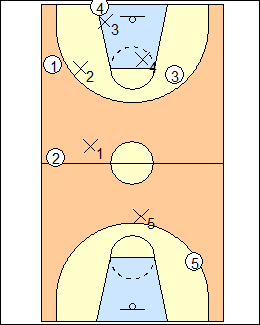 | 1 Canada Basketball The 1-2-1-1 fullcourt press is often used to pressure the inbounds pass and quickly trap the ball. Point X3 is usually a mobile forward who can pressure the inbounds pass and trap well, although a centre can be used, allowing a quicker defender at the back of the press. Left wing X2 is a guard or small forward who is the best trapper (most inbounds passes are made to this side), right wing X4 is a forward or guard who will have to contest passes to his side then act as an interceptor. Centre X1 is a guard or small forward who can intercept passes and slow down the break if a trap is beaten. Safety X5 is often the tallest player, he guards against the deep threat and must be a good defender in disadvantage situations. A good 1-2-1-1 press can - deny the inbounds pass - trap if the inbounds pass is made - defend on a pass back to the inbounder - trap on reversal to the other side - trap again on a pass up the sideline - hustle back when the press is beaten. |
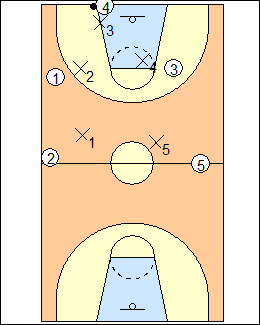 | 2 To deny an inbounds pass, defenders must match up, if the press offence brings five players into their backcourt, safety X5 is responsible for the player opposite the ball. If the inbounds pass can't be denied, it should be influenced to either corner. Ed Webb (Winning Hoops) - there are four ways to play the zone press, - regular - allow the inbounds pass - overplay - deny the inbounds pass - double-team the opponent's best guard with X3 (who face guards) - rover - X2 and X4 overplay, X3 faces the ball in the middle and calls out where the pass is being thrown. Alan Lambert - full inbounds denial disguises the zone press, works best if your team is athletic, and may be needed to catch up quickly late in a game. Dean Smith - if an inbounds pass is made over X2 to 2, X2 can come back to double-team with X1, X5 and X3 would be interceptors, and X4 the goaltender. See Defences - 1-2-1-1 Alan Lambert, Australia (50 off, the wing defenders face guard, encouraging a lob pass over the top for an interception or trap). |
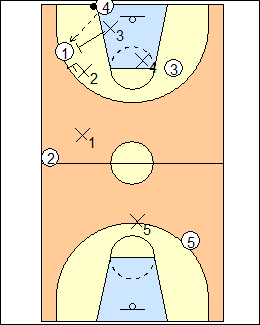 | 3 Trapping after the inbounds pass is often a quick trap (shown), in some presses the ballhandler is encouraged to dribble up the sideline (a laning principle). Alan Lambert - if the inbounder cuts downcourt after passing, X3 follows him until the level of the ball, then traps and releases defensive responsibility to X4. Using a quick trap and delayed trap can add variation to your press attack. The press is beaten if the ball gets to the middle of the court behind the first line of defenders, X1 should slow the ballhandler and all other defenders retreat immediately. Dean Smith - on a perimeter pass, try to double-team the receiver, on a gut pass, or once the ball penetrates the hash marks in their backcourt, the press is broken, the defence sprints back, picking up man-to-man. See Defences - 1-2-1-1 Kentucky, Thumbs up (trapping off the dribble). |
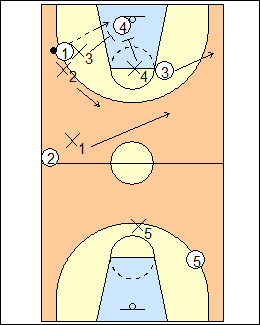 | 4 A pass back to the inbounder is often least contested by interceptor X4, especially if the inbounder is a post player who is not a threat to dribble the ball. It may be possible to trap the inbounder (shown), but the passing lanes are excellent when the ball is in the middle of the court. An effective strategy is to match up then influence the ballhandler toward either sideline, allowing a trap. To practice the press, coach can hand a ball to 1 in the trap and play begins. Extra pressure can be put on the press by adding an additional offensive player (for 6 on 5). Dean Smith - they usually suggest that X4 try to encourage a pass to 4 since a pass to the middle would break the press, while a pass to 4 gives them another opportunity to double-team deep in the opponent's backcourt. See Defences - 1-2-1-1 Australia, John Kimble (denying a return pass to 1). |
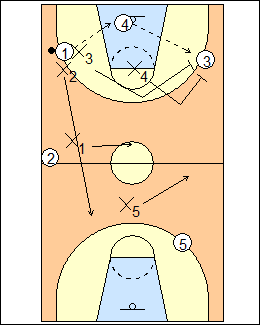 | 5 The attacking team often inbounds to one side then reverses the ball, some coaches consider that the press is broken and retreat to their halfcourt offence (one and done), another option is to trap again. When the ball is reversed to the inbounder, X4, X3 and X2 drop back diagonally, X1 cuts off the middle of the court. On a pass to 3, X4 and X3 move up to trap, X5 becomes the ballside interceptor, X1 is the middle interceptor, and X2 rotates back as safety. See Defences - 1-2-1-1 Kentucky, Basics (X1 mirrors the ball to become the ballside interceptor, and X5 is always the safety). Alan Lambert - if the attacking team uses a long lateral skip pass, it may be difficult for X1 to take away a pass to a weakside deep attacker coming back to the ball, in this situation X1 and X5 exchange coverage. |
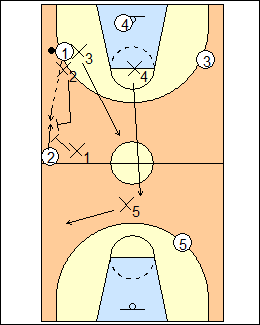 | 6 |
This page was made with Basketball playbook from Jes-Soft
